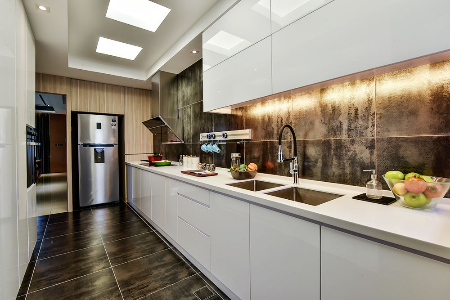Blog categories
Blog archive
RSS Blog posts tagged with 'materials'
Blog Filters
Choice Cabinetry: 6 Kitchen Cabinet Design Ideas That Totally Transform Your Cookspaces
Friday, November 20, 2020
As we pointed out previously in our guide on colours for the kitchen, it doesn't always have to be in white - although it usually is. This time around we take a look at a range of approaches to cabinets that will not only provide your kitchen with a different shade - but an altogether unique appearance as well.
1. Wood Wood is coming back to our homes, thanks in part to the shifting mood regarding global climate change, we have been seeing a return of both laminates and hardwood in cabinetry bearing shades of reclaimed or varnished wood to complement rustic and modern kitchens alike. The homage to this natural material does not necessarily need to be overt - even when constructed from completely synthetic materials, cabinets can be decorated with cuts or classically-inspired detailing to imply that some carpentry was involved.
 Designer: Nu Infinity
Designer: Nu Infinity
2. Concrete Grey Exposed concrete is another material spotted making a resurgence, helping to create a masculine ambiance when paired with minimalist furnishings in post-industrial properties. While the use of actual concrete on cabinet doors would be impractical, the characteristic tone and blemishes of cement can be reproduced with a few coats of thinned grey paint on unvarnished wood to complement an industrial decor.
 Designer: X-Two Concept
Designer: X-Two Concept
3. Glossy / Reflective Glossy cabinetry is not a new component of 21st century kitchens, having been in heavy use since the processes behind laminates have expanded to produce a wide range of finishes. Give that sheen a purpose by selecting a material with an ultra-glossy or reflective finish for your cabinets, to visually enlarge the space and bestow your kitchen with a palatable elegance.
 Designer: Zanotta Studio Design and Renovation
Designer: Zanotta Studio Design and Renovation
4. Transparent Adaptable to a wide range of styles and colours, using completely transparent or frosted glass doors on your cabinets immediately turns your storage into display cases that can be completed with luxurious facility when fitted with internal lighting.
 Designer: Space Living
Designer: Space Living
5. Metallic We've mentioned before that serious chefs seem to gravitate towards stainless steel countertops, and we are just as certain about their receptiveness to steel cabinetry. The clean and durable look and feel of steel lends itself well to post-industrial interiors, providing a greater measure of modern elegance than cement in the seamless welded joints and folded laps of steel sheeting.
 Designer: Archicentre
Designer: Archicentre
6. Underfoot Lighting We have all probably seen the use of LED strips embedded beneath upper cabinets to illuminate countertops, but you probably have not seen that same form of fixture being used beneath lower cabinets to light the floor. More mood lighting than task lighting, these LED strips introduce a dose of glam into what would be otherwise bland spaces.
 Designer: Jashen Interior Design
Click here to see more kitchens!
Designer: Jashen Interior Design
Click here to see more kitchens!

Counter Balance: How to Choose the Best Kitchen Countertop Surfaces
Friday, November 20, 2020
With all the various materials available for kitchen countertops, we figured you could do with some pointers on how to choose the most appropriate surface to suit your needs and your décor, so we gathered our team of experts and let them loose in our kitchens to help us put together what has turned out to be the internet's most definitive guide on materials for kitchen countertop surfaces.
Kitchen countertops can be formed out of completely natural or synthetic materials, or even some combination of both - all presenting different challenges. Your choice of material may be dependent on its colour and appearance, or what that selection says about your personality - but a forward-planning homeowner should also consider cost, availability, workability, durability, and maintenance needs before settling on a choice of a particular material.
 Designer: Craftsmen Valley
Designer: Craftsmen Valley
First of all, before settling on a particular material for surfaces that may become permanent fixtures in your kitchen, one should view and feel samples or mock-ups in person rather than depending on images to be accurately representative - as camera lenses, photo filters, and imaging algorithms sometimes do unpredictable things when reproducing real-life examples.
Laminates Since Formica® was popularized in Europe in the 1950s, laminates have made reappearances in the 1970s and in modern times to affect vintage interiors. Being a material largely composed of sheets of textile or fabric soaked in plastic resins, laminates are easily the most affordable material for kitchen surfaces. Various colours and textures are easily attained with the addition of pigments or thin sheets of natural materials into the compositions, meaning that the availability of laminates is likely the highest among all other materials. However, laminates will fade in direct sunlight and despite their highly synthetic composition, they do not stand up well to excessive moisture or corrosive chemicals such as some cleaning fluids. Although reputed to be susceptible to scratches and to scorching at high temperatures, laminates using modern formulations of resins have greatly increased their resistance to burns and scratches, as well as other forms of wear and tear in recent years.

Designer: IKEA
Wood The warming tones and grains of wood are ideal for creating a rustic or country atmosphere, working equally well when set within modern décors as accents. Wood is simple to work with, a fact that any high school student who has been subjected to woodworking classes can attest to. Wood is also highly workable, enabling curved surfaces that cannot be matched by the majority of engineered materials. Due to their natural origins and versatility in a wide range of interiors, wood is highly priced and limited in availability, meaning that finding large amounts of matching tones and grains may be a challenge. This much sought-after natural material requires a greater degree of care to maintain on account of its relative softness and porosity: wood is easily scratched, although the damage can be removed with sandpaper, but water is perhaps a wooden surface's worst enemy - requiring coats of varnish and regular doses of wood oil to seal gaps and prevent water from seeping in, which would result in the wood rotting from the inside and smelling of a wet forest.
 Designer: Casa Indah Design
Designer: Casa Indah Design
Concrete Countertops composed of cement and aggregate have been spotted making a resurgence in modern interiors ranging from minimalist to industrial. Relatively low in cost and high in availability, concrete surfaces can be customized in a wide variety of ways. Due to their initial liquid-like slurry state, concrete surfaces can be dyed with pigments, trowelled to form seamless curves, stamped with designs, pressed for marbled veins, or polished to a smooth finish. Concrete surfaces are highly resistant to scratches when fully set, but care should still be taken around this material as it can warp or even crack with extreme fluctuations in temperature, it also discolours with moisture and is susceptible to etching by mild acidic solutions. Due to their porosity when cured, concrete surfaces must be maintained with coats of sealer regularly applied every few months to prevent staining.
 Designer: Nevermore Design
Designer: Nevermore Design
Stone Natural stone such as granite, and softer stone such as marble, limestone, or soapstone have been popular in the last few decades, due in part to their timeless beauty and unique patterns. Natural stone has to be quarried from the handful of locations around the world known to be fortunate enough to have these beautiful materials thrust through the crust - as a result, the cost of acquisition is relatively high and dependant on the stone's origin and appearance, with availability being almost never guaranteed. Granite is the most durable, but like the rest of the popular stone materials, their natural porosity requires regular maintenance in the form of sealing coats.
 Designer: FIX Design Solutions
Designer: FIX Design Solutions
Solid Surface Typically composed of two-thirds mineral dust and one-third polymer resins, solid surfaces are perhaps the most versatile of all stone-based materials. Solid surfaces can be dyed with pigments and shaped into seamless curves in the same manner as concrete. Due to their composition being based on a by-product of quarrying activities, solid surface materials entail a reduced environmental impact, and they are relatively affordable in comparison to natural stone. Softer than granite, solid surfaces can be scratched - but the damage can be removed by sanding and polishing. Unlike natural stone, solid surfaces are non-porous and do not require sealing at the manufacturing level and little to no maintenance. Availability and installation may be an issue with this material, as the ownership of the high-technology facilities required to manufacture and install solid surface countertops are restricted to a few select entities.
 Designer: Havana Konzept
Designer: Havana Konzept
Quartz On the most durable end of the scale is quartz - often called engineered stone, which is composed of crushed stone that would otherwise have been discarded but is instead mixed with pigments and polymer resins to bind them together into the toughest possible material for your countertop. Quartz has been often touted as the material most resistant to scratches and heat, due to the high proportion of stone relative to synthetic materials in the composition of kitchen countertops. The dependence on unwanted stone rather than quarrying new materials makes quartz a more eco-friendly choice when compared against natural stone. The challenges with quartz are few, but considerable in importance: due to their manufacture being dependant on supplies of crushed stone, their cost is likely the highest among all other materials, availability in particular colours or styles may be limited, and by virtue of their hardness - quartz is the heaviest and most difficult material to install without professional assistance.
 Designer: Caesarstone
Designer: Caesarstone
Steel The preferred choice of serious chefs everywhere, steel stands up best to scratches and chemicals - especially when provided with a protective coating composed of polymers or carbon molecules. Various grades of steel are churned out from all corners of the globe, making this material one of the most available - but the heavy equipment and high level of expertise required to work steel into the forms necessary for kitchen countertops makes for relatively difficult and costly custom installations.
 Designer: Officine Gullo
Designer: Officine Gullo
Detailing and Finishes Once you have juggled all the various considerations that go into selecting the material for your kitchen countertop, its appearance, cost, availability, workability, durability, and maintenance needs - you cannot forgo putting some thought into the kind of detailing and finishes you want. Consider details such as bevels or curves to soften hard edges, and polishing the surface smooth for a reflective sheen, or dull for a matte finish to downplay the surface's prominence. You could even take things to the next level by mixing materials together: think a wood block framed in stone, for example.
Click here to see some more kitchens!




